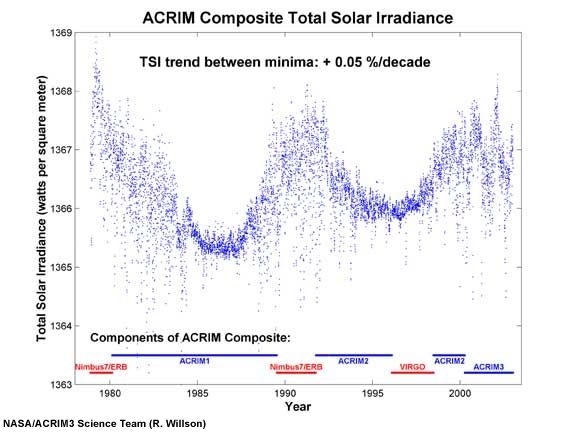
Solar Irradiance.
The answer may lie in particle physics.
The current approach used to describe climate change (Global Warming) has put the cart in front of the horse. The basic assumption ingrained into the Global Warming Doctrine (doctrine because it is treated more like an environmentalist manifesto than a scientific theory) is that humans are predominately responsible for recent climatic changes. The first step of a scientific approach to describing climate change would be to define the natural mechanisms that affect the environment. It would seem logical that only after the natural model is developed and refined could the effects of man-made components be quantified to explain any deviations.
Recently several individuals contributed to establishing a natural climate change model. These studies have focused on the Sunís influence on climate change. Pang & Yau (2002) studied solar irradiance and strongly correlated this data with Northern Hemisphere temperatures from the years 1620 to 1980. Willson (2003), using satellite observations of Total Solar Irradiance (TSI), has observed a 0.05 percent increase per decade in the Sunís radiant energy since 1970, which can account for some of the uptick in global temperature rise. These studies provide a foundation for the development of a natural climate change model.


Another component in the natural climate change model lies in particle physics. In 1894, Charles Wilson began researching water droplets that make up clouds. He developed a device called a cloud chamber, which allowed him to reduce the air pressure of a humid environment. He discovered that charged particles traveling through the chamber left a trail of condensed water droplets. He received a Nobel Prize in 1927 for inventing the bubble chamber.
The Earthís environment functions like a cloud chamber. But the Earthís magnetic field shields the planet from charged particles, which are deflected towards the Poles, where the cold temperatures produce low humidity levels that inhibit cloud formation. The Earthís magnetic field has been on the decline. Recently, the decline has become very pronounced. Using the International Geomagnetic Reference Field (IGRF) data set, the magnetic field at the equator in open ocean has declined 1.7 percent in intensity since 1980. (Geomag program, IGRF dataset, latitude 0 degrees, longitude 180 degrees, years 1980-2005, a decline from 34,824 to 34,246 nanoTesla (nT)). Whereas the entire decline over the period from 1900 to 1980 was 2.8%.
As the Earthís magnetic field strength declines, charged particles from outer space and from the Sun will find it easier to break through the magnetic shield that protects Earth. These particles then interact with humid air in tropical, subtropical and mid-latitude environments to produce tiny water droplets that become basic building blocks in forming clouds. Increased cloud formation can result in increased global rainfall and snowfall totals. These clouds can also moderate Earthís temperature by reflecting solar radiation.